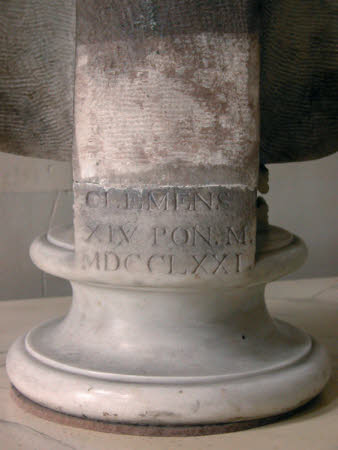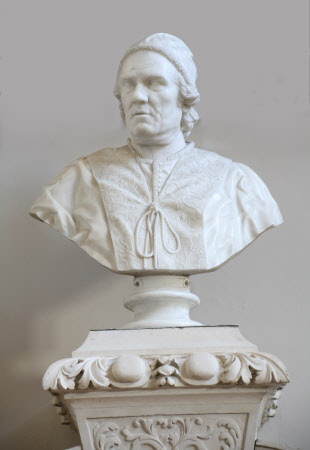Pope Clement XIV (Giovanni Vincenzo Antonio Ganganelli) (1705-1774)
Christopher Hewetson (Thomastown c. 1736 - Rome 1798)
Category
Art / Sculpture
Date
1771 (inscribed)
Materials
White marble
Measurements
80.5x67x32.5
Place of origin
Rome
Order this imageCollection
Beningbrough Hall, North Yorkshire
NT 1191237
Caption
When did the word ‘condescension’ take on a pejorative meaning? One asks because it appears in correspondence related to this marble bust of Pope Clement XIV which was brought to England in 1771 by Mr and Mrs Earle of Beningbrough Hall. The couple had been travelling in Rome when Mrs Earle received papal permission to rest in a convent. Her husband later wrote that the Pope had 'shown us many marks of the most condescending distinction'. Mr Earle presumably bought this bust as a memento of what was for him, clearly a pleasant encounter. Clement XIV, pope from 1769 to 1774, was described as a man of formidable physique, and the present sculpture attests to this. The sculptor, Christopher Hewetson, skillfully conveys the Pontiff's fleshy, lined features and discerning sideways glance. He is most certainly an imposing presence. Hewetson was born in Ireland but spent his career in Rome in the circle of neo-classicists. His busts of Clement XIV, of which this is the earliest of four versions, were acquired by Grand Tourists, often on the advice of the Scottish neoclassical painter and antiquities hunter, Gavin Hamilton. Clement XIV planned but did not live to carry out a radical extension of the Vatican Galleries and acquired much of the antique statuary for it from Hamilton. It was almost certainly through him that the pope was introduced to the Irish sculptor. The aforementioned Mrs Earle, née Margaret Bourchier, was the niece and heiress of John Bourchier, who completed Beningbrough Hall in 1716. The Earles were in Rome from 1770 where they stayed at Cardinal Albani’s villa in the town of Castel Gandolfo where the pope also had a summer palace. Perhaps they had the occasion to enjoy papal condescension on more than one occasion.
Summary
White marble sculpture, Pope Clement XIV (Giovanni Vincenzo Antonio Ganganelli, 1705-1774) by Christopher Hewetson (Thomastown 1737 - Rome 1798), inscribed and dated Clemens XIV Ponti MDCCLXXI, Rome 1771.
Full description
Hewetson, born in Ireland, lived in Rome from about 1764 until his death and was friendly with the neo-classicists. This is the earliest of six known versions of this portrait bust and was almost certainly acquired by Giles and Margaret Earle of Beningbrough while in Italy during their 1770-71 Grand Tour; possibly on the advice of the Rome-based art dealers Gavin Hamilton or James Byres (who wrote to William Burton of Burton Constable, East Yorkshire about meeting the Earles in Rome, East Riding Record Office DDCC/145/6 N.B. recipient misidentified as Sir William Hamilton in ‘A Dictionary of British and Irish Travellers in Italy, 1701-1800’ by Brinsley Ford & John Ingamells, 1997). Surviving correspondence sent from Rome by Giles Earle to his friend and attorney, Timothy Mortimer (Hull History Centre U DDBHI26/31) includes a remark that Pope Clement XIV had, "shown us many marks of the most condescending distinction", including special permission for Margaret, "to spend a whole day in a convent of nuns. She stayed with them from 10 o’clock 'til eight at night, and never passed a more agreeable day in her life". Clement XIV had a reputation for welcoming wealthy Protestant visitors such as the Earles which, combined with his refusal to recognise the exiled Stuart family as legitimate heirs to the English and Scottish throne, encouraged the Pope's personal popularity in Britain, as reflected in sales of this bust. The bust is the only one of a number of Grand Tour souvenirs acquired by the Earles to have stayed with the house, passing with successive owners and likely always displayed on the mantlepiece in the entrance hall except for occasional loans to exhibitions, starting with the Yorkshire Fine Art and Industrial exhibition in York in 1866 (item 865).
Provenance
Probably acquired by Giles (1732 - 1811) and Margaret Earle (1739 - 1827) in Italy in 1771, bequeathed with Beningbrough Hall to the Reverend and Hon. William Henry Dawnay (later Viscount Downe) and passed by descent; sold with house and to the 10th Earl and Countess of Chesterfield, 1917; accepted in lieu of tax from HM Treasury from the estate of Lady Chesterfield (1878 -1957) in 1958
Makers and roles
Christopher Hewetson (Thomastown c. 1736 - Rome 1798), sculptor
Exhibition history
The Treasure Houses of Britain, National Gallery of Art, Washington, USA, 1985 - 1986, no.190 Souvenirs of the Grand Tour, Wildenstein & Co., London, 1982, no.53
References
Hodgkinson 1958 Terence Hodgkinson, Christopher Hewetson, and Irish Sculptor in Rome, Walpole Society, XXXIV, 1958, pp. 42-54 Whinney 1971 Margaret Whinney, English Sculpture (V&A Museum), 1971, 110





